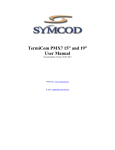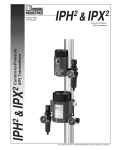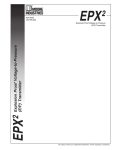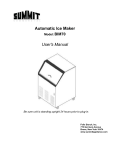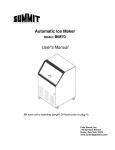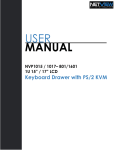Download SENSOR ENCLOSURE SERVICE MANUAL
Transcript
SENSOR ENCLOSURE SERVICE MANUAL V5.0 October, 2010 CONTENTS CHAPTER 1 .......................................................................................................................................................................... 4 1.0 SENSOR HEADS .................................................................................................................................................. 4 1.1 OVERVIEW ......................................................................................................................................................... 4 1.2 HEAD ALIGNMENT............................................................................................................................................. 4 1.3 HEAD ANGLE ALIGNMENT ................................................................................................................................. 5 1.4 SIGNAL, GROUND & AIR CONNECTIONS ........................................................................................................... 5 1.4.1 SIGNAL PLUG................................................................................................................................................. 5 1.4.2 GROUND ....................................................................................................................................................... 6 1.4.3 COMPRESSED AIR ......................................................................................................................................... 6 1.5 COVER REMOVAL .............................................................................................................................................. 6 1.6 CLEANING THE SENSOR WINDOWS .................................................................................................................. 7 CHAPTER 2 ........................................................................................................................................................................ 13 2.0 POWER SUPPLY & DISTRIBUTION PCB ............................................................................................................ 13 2.1 FUNCTION OF THE POWER SUPPLY & DISTRIBUTION PCB ............................................................................. 13 2.2 DESCRIPTION OF THE POWER SUPPLY & DISTRIBUTION PCB ......................................................................... 13 2.2.1 DC/DC CONVERTER FOR THE +5V, +15V & ‐15V SUPPLIES ......................................................................... 13 2.2.2 DC/DC CONVERTER FOR THE ‐400V & ‐150V SUPPLIES .............................................................................. 14 2.2.3 VOLTAGE DISTRIBUTION ............................................................................................................................. 14 2.2.4 HEATER CONTROL ....................................................................................................................................... 14 2.3 TROUBLESHOOTING THE POWER SUPPLY & DISTRIBUTION PCB ................................................................... 14 CHAPTER 3 ........................................................................................................................................................................ 24 3.0 ENCLOSURE ELECTRONICS & WIRING ............................................................................................................. 24 3.1 OVERVIEW OF UPPER & LOWER HEADS ......................................................................................................... 24 3.2 EDGE SENSORS ................................................................................................................................................ 24 3.3 MAGNETIC SENSOR ......................................................................................................................................... 25 3.4 LED INDICATORS.............................................................................................................................................. 25 3.5 HEAD WIRING .................................................................................................................................................. 25 CHAPTER 4 ........................................................................................................................................................................ 26 4.0 HEATER CAVITY & AIR CURTAIN ...................................................................................................................... 27 4.1 PURPOSE OF THE HEATER CAVITY................................................................................................................... 27 4.2 CAVITY ASSEMBLY LAYOUT ............................................................................................................................. 27 4.3 CONTROLLED SURFACE AND AIR CURTAIN HEATER CIRCUITS........................................................................ 28 4.3.1 SURFACE HEATERS ...................................................................................................................................... 28 4.3.2 AIR CURTAIN HEATERS ................................................................................................................................ 28 4.4 TEMPERATURE SENSORS & TEMPERATURE CONTROL ................................................................................... 28 4.4.1 THERMISTER ............................................................................................................................................... 29 4.4.2 IC TEMPERATURE SENSOR .......................................................................................................................... 29 4.5 INSULATION OF THE CAVITY ........................................................................................................................... 29 4.6 REMOVAL OF THE CAVITY ASSEMBLY ............................................................................................................. 30 4.7 AIR CURTAIN AIR FLOW................................................................................................................................... 31 CHAPTER 5 ........................................................................................................................................................................ 36 5.0 COOLING & AIR DISTRIBUTION ....................................................................................................................... 36 5.1 COMPRESSED AIR DISTRIBUTION.................................................................................................................... 36 5.2 VORTEX TUBE COOLER .................................................................................................................................... 36 5.3 HEAT EXCHANGER, ELECTRONIC COOLER & FAN............................................................................................ 37 5.4 ENCLOSURE AIR PURGE................................................................................................................................... 37 5.5 BASIS WEIGHT/ASH SOLENOID AND AIR CYLINDER ........................................................................................ 37 The Leader in Measurement & Control 2 of 42 CHAPTER 1 SENSOR HEADS The Leader in Measurement & Control 3 of 42 CHAPTER 1 1.0 SENSOR HEADS 1.1 OVERVIEW The sensor enclosures are manufactured entirely from aluminium to the highest tolerances,. The sturdy design ensures a stable mounting for the sensors as well as proper protection for the enclosed electronics. Because of the close manufacturing tolerances and design, the paper gap is a uniform 8 mm deep (for Microwave application). This small gap ensures the highest accuracy by reducing the air column and bringing source and receiver closer together. The surface of the enclosure is black anodise finished and the parts fastened together with only stainless steel fasteners. The removable covers are also aluminium with stainless steel spring clip fasteners for quick removal. The covers seal to the head assembly by means of a silicone rubber “o” ring. This model of enclosure can house up to 3 sensors internally and has mounting holes for external sensors if needed. Within the enclosure, as well as the sensors themselves are integral edge of sheet sensors, power supply and distribution PCB. Enclosure cooling is by way of a vortex cooled heat exchanger with fan. Cooling is controlled by adjustment to the vortex compressed air supply. The enclosure is insulated internally to keep out the process heat. For accurate measurement of the paper properties, the Upper and Lower heads must be in exact registration throughout the scan. Proper alignment of the heads is important. 1.2 HEAD ALIGNMENT If the top and bottom heads are not exactly aligned the measurement can be affected. to align the heads is as follows: The procedure 1. Insert the two spacer bars into the head gap and place in approximate position. 2. Slacken the head mounting screws of the Upper Head so that it can move relative to the Lower Head. 3. Insert the four long bolts into the alignment holes of the Upper Head, through the holes in the spacer bars, and then through the alignment holes of the Lower Head. Insert the washer and nut, and screw the heads together tightly. The heads should now be in perfect alignment. 4. Tighten the mounting screws of the Upper Head and remove the alignment bolts. 5. Check that the heads are in exact alignment by passing the alignment bolts through the holes top to bottom. The bolts should pass easily in all four positions. 6. If the alignment is still not correct, check that the lower head is not twisted and repeat the procedure. The Leader in Measurement & Control 4 of 42 1.3 HEAD ANGLE ALIGNMENT This procedure is required if the angle of the heads is not exactly the same as that of the paper. Ideally the paper should pass through the centre of the gap without the heads touching the paper or changing the paper path. The alignment should be done as close as possible to this ideal. To adjust the head angle, proceed as follows. 1. Bolt the Upper Head and Lower Head together using the spacer bars, as in the Head Alignment procedure above, making sure the heads are in perfect alignment with respect to each other. 2. Carefully slacken both the upper and lower head mounting bolts so that the heads can be moved and rotated. At least 2 people are needed to control the heads. 3. Rotate the heads until the correct angle is reached. scanner. 4. Re-tighten all the mounting bolts for both heads to hold the heads in the new position. the heads do not twist. 5. Remove the alignment bolts and spacers and check that the heads remain at the correct angle AND that the head alignment is still correct. 1.4 SIGNAL, GROUND & AIR CONNECTIONS Ensure that the heads are still centred on the Make sure Each sensor head has 3 types of connectors for: Signals (including +24V power & return); Ground; and Compressed air. Each is described below: 1.4.1 SIGNAL PLUG The electrical signals are connected to the sensor head by means of a multi-pin military style connector. The connector supplies +24V power, +24V return, signals to the sensor and signals from the sensor. To remove or reconnect the plug, do the following: 1. Turn off all the power to the scanner. 2. Twist the body of the connector anti-clockwise. 3. Protect the plug and socket from dirt and damage by wrapping the end with protective materials. 4. To reconnect the plug, do the above in reverse. The Leader in Measurement & Control The plug will release. 5 of 42 1.4.2 GROUND The sensor head is grounded via cables in the power track. This is to discharge any static electricity directly to ground. 1.4.3 COMPRESSED AIR Compressed air is supplied to each head for: 1. Shutter operation. 2. Enclosure cooling 3. Enclosure pressurization 3. Air curtain To disconnect the compressed air, do the following: 1. Turn off the air supply to the scanner. 2. Remove the air supply tube by pushing the release ring of the connector and pulling out the tube from the connector. Reconnect in the reverse order. Note: The compressed air supply should be adjusted at the regulator for 60-80PSIG 1.5 COVER REMOVAL In order to service the sensors and head electronics, the head covers will need to be removed. The covers are removed simply by unclipping the stainless steel spring fasteners, 4 per cover. The cover can then be removed and placed in a safe location. Care should be taken when removing or replacing a cover that the cover does not short or damage the electronics inside the enclosure. Also note that although the covers are identical, the fasteners of each cover are adjusted to the cover position, therefore ensure each cover is returned to the same position. The Leader in Measurement & Control 6 of 42 1.6 CLEANING THE SENSOR WINDOWS In order to ensure the continued accuracy of the sensor measurement, the sensor windows should be cleaned on a regular basis. The frequency of cleaning depends on the mill environment, but even in a clean environment, the sensor windows should be cleaned and inspected at least once per week. The procedure for cleaning the sensor windows is as follows: 1. Send the scanner Off Sheet. 2. Ensure the shutter is closed - the Green light should be ON and the Red Shutter Open warning light should be OFF. THIS IS VERY IMPORTANT FOR SAFETY. 3. Press the Head Separate button. 4. VERY GENTLY clean the sensor windows with a clean lint-free rag moistened with alcohol. especially careful not to damage the basis weight windows which are very fragile. 5. Clean the edge sensor windows - there are 2 sapphire windows each 10mm in diameter. 6. After cleaning the windows, inspect each to ensure the windows are not damaged. Especially check the basis weight windows to ensure there is no hole that could allow dirt into the sensor. If any window is found to be damaged, the window should be replaced immediately. 7. After completing the cleaning of the windows and removal of any tools or materials from the sensor area, press the Off Sheet button. The heads will realign automatically. 8. After waiting until the scanner head automatic alignment procedure is completed, the scanner can be scanned again. The sensor will automatically standardise first. The scanner heads will separate automatically. The Leader in Measurement & Control 7 of 42 Be The Leader in Measurement & Control 8 of 42 The Leader in Measurement & Control 9 of 42 The Leader in Measurement & Control 10 of 42 The Leader in Measurement & Control 11 of 42 CHAPTER 2 POWER SUPPLY & DISTRIBUTION PCB The Leader in Measurement & Control 12 of 42 CHAPTER 2 2.0 POWER SUPPLY PCB 2.1 FUNCTION OF THE POWER SUPPLY PCB The Power Supply and Distribution board has a number of important functions: 2.2 1. Provides +5V, +12V, -12V, +15V, -15V, +24V, -400V & -150V supplies. These voltages are converted from +24V input. It therefore provides all the power needed by the sensor electronics and other electronics in the heads. Note that the +/- 12V is derived via sub regulation from +/15V. 24V supply for the heaters is from a separate supply. 2. Provides the temperature control of the surface & air heaters. Temperature feedback is from thermisters and the circuit turns the heater transistors on and off as appropriate. There are two temperature control circuits, one for the Air Heaters and one for the main place to the head. The temperature for each can be adjusted on this board via potentometers. Note that turning the potentiometer clockwise decreases the controlled temperature. 3. Provides easy distribution of the power supplies by simply plugging into this board and tapping the appropriate voltages. All external connections are through the use of Molex connectors, allowing easy connection and disconnection during servicing. 4. Provides diagnostic LEDs to detect fuse failure or failure of the +5V, +15V or -15V supplies. DESCRIPTION OF THE POWER SUPPLY PCB Please see the circuit & lay-out drawings below. A description of the Power Supply and Distribution board circuit can be broken down into sub-circuits as follows: 2.2.1 DC/DC CONVERTER FOR THE +5V, +15V & ‐15V SUPPLIES The triple output DC/DC converter, converts the +24V input into 3 separate outputs of 5V, +15V & 15V. The DC/DC converter is internally protected against overload. If a short circuit occurs, then it should protect itself by turning off. The converter will only turn back on when the short has been removed. For this reason do not immediately assume that a voltage failure problem is with the DC/DC converter. First remove all output connectors and re-test. If it is now OK then reconnect one at a time until the problem external circuit is identified. The Leader in Measurement & Control 13 of 42 2.2.2 DC/DC CONVERTER FOR THE ‐400V & ‐150V SUPPLIES The VH-10 DC/DC converter provides high voltage sufficient to drive the Ion Chamber of the Basis Weight and Ash Sensors. The output of this device is proportional to the input voltage. In this circuit the VH-10 DC/DC converter is powered from the +5V of the DC/DC converter and this gives an output of -370 to-400V. Zener diodes provide a step down from -400V to -150V to drive the PbS Cells of an IR Moisture Sensor. 2.2.3 VOLTAGE DISTRIBUTION The voltages +5V, +12V, -12V, +15V, -15V, -150V & -400V are distributed to user electronics via connectors Users of the voltage supplies (sensors, support electronics etc.) simply connect to the appropriate pins of the connectors. 2.2.4 HEATER CONTROL This part of the Power Supply & Distribution PCB controls the temperature of the surface and of the air curtain air by turning on and off resistor heaters. The circuits use Operational Amplifiers to compare the temperature as measured by thermistors to the temperature set-point of the potentiometer. The circuit drives the heater transistors. 2.3 TROUBLESHOOTING THE POWER SUPPLY & DISTRIBUTION PCB The method of troubleshooting the Power Supply & Distribution PCB depends on the type of trouble that is occurring. Therefore first determine if the problem is: a) A power supply problem b) A heater control problem After determining the type of problem then, look at the circuit drawing to help trouble shoot that part of the circuit. The Leader in Measurement & Control 14 of 42 The Leader in Measurement & Control 15 of 42 HEAD POWER SUPPLY PCB CIRCUIT DRAWING The Leader in Measurement & Control 16 of 42 HEAD WIRING DISTRIBUTION PCB 2.4 TROUBLESHOOTING HEAD WIRING DISTRIBUTION PCB The purpose of the Head Wiring PCB is to make the complex wiring within the head easy to do and easy to troubleshoot. Most of the wiring is on push-in connectors that can be quickly disconnected to change this board or to troubleshoot. 2.5 SENSOR & SIGNALCONNECTIONS Each Sensor connects to a plug on the Distribution PCB making it easy to troubleshoot. All signals go through this board. External LEDs, solenoids, flag, IR Gain, magnetic switch, edge of sheet sensors etc., all connect to and through this board. 2.6 DIAGNOSTICS The Head wiring distribution pcb provides LED diagnostics: • Air and Surface heating on/off yellow LEDs • Flag and Shutter Solenoid Blue LEDs. • IR Gain, Magnetic Switch, Edge Sensor yellow LEDs • Shutter open/closed red/green radiation warning light LEDs. The Leader in Measurement & Control 17 of 42 LAYOUT OF THE HEAD WIRING DISTRIBUTION PCB The Leader in Measurement & Control 18 of 42 CIRCUIT OF HEAD WIRING & DISTRIBUTION PCB The Leader in Measurement & Control 19 of 42 SENSOR SIGNALS The Leader in Measurement & Control 20 of 42 UPPER HEAD WIRING The Leader in Measurement & Control 21 of 42 LOWER HEAD WIRING The Leader in Measurement & Control 22 of 42 CHAPTER 3 ENCLOSURE ELECTRONICS & WIRING The Leader in Measurement & Control 23 of 42 CHAPTER 3 3.0 ENCLOSURE ELECTRONICS & WIRING 3.1 OVERVIEW OF UPPER & LOWER HEADS The sensor heads are sturdily constructed of anodised aluminium parts fastened with stainless steel screws. Upper and lower parts are mirror images of each other with only very minor differences to accommodate the magnet of the magnetic head separation sensor. Once assembled the only parts that should normally ever be disassembled for maintenance purposes are the covers for maintenance access and the heater cavity platform assembly. Any disassembly of the heater platform assembly should only be attempted after carefully studying the section in this manual on the “Heater Cavity and Air Curtain”. This model of enclosure is designed to fully house up to 3 sensors (standard) or 4 sensors, each having an upper source side and a lower receiver side, as well as all support electronics. As well as the 3 or 4 sensors that can be housed within the assembly, the heads are designed to allow additional sensors to be bolted on to the sides in the MD direction - one additional sensor each side if required. Head separation of 5 – 10mm (depending on application) ensures ample gap for paper clearance while minimising the adverse effects of varying air column density and sheet movement. No sensor, however constructed and compensated is completely insensitive to these effects and minimising the gap minimises any such adverse effects. In addition, bringing source and receiver closer together increases the received signal and increases signal to noise ratio. This is especially true for the Basis Weight Sensor. For the reliable detection of the sheet, while fully protecting the electronics, each head houses two 10mm diameter Windows. Infra-red light from the Edge Sensor source, located in the upper head, passes through the paper and to the detector in the lower head. The window stops any dirt getting into the head and provides a tough, scratch & wear resistant surface. A Magnet set into the upper head is designed to activate a Reed Switch in the lower assembly when the heads are in close proximity. This interlock is used to ensure that the shutter will close automatically if the heads should separate for any reason. This is part of the radiation safety features of the system. 3.2 EDGE SENSORS Transmission type Edge of Sheet Sensors, are normally provided, however for light weight tissue these do not work reliably. Instead the signal from either the Basis Weight Sensor or the IR Moisture Sensor is used to trigger the “edge” since the sensor signal must change between on-sheet and off-sheet. Sensitivity adjustment is on the receiver side (lower head) as is the polarity switch. The Leader in Measurement & Control 24 of 42 3.3 MAGNETIC SENSOR The purpose of the Magnetic Sensor is to detect if the heads are separated or misaligned by more than about 50mm. This is achieved by a magnet located in the UPPER head and a reed switch type proximity detector in the corresponding side of the LOWER head. Whenever the heads are aligned the close proximity of the magnet causes the reed switch to close. When the heads separate by more than about 50mm, the reed switch will open. The Magnetic Sensor is part of the safety interlocks of the system and essential for good radiation safety. It prevents the source shutter solenoid from operating unless the heads are closely aligned. If the heads separate for any reason, the opening of the reed switch will cause the release of the shutter solenoid and the closure of the shutter. This prevents the possibility of the shutter being open without the lower head being in place to act as a radiation shield. There are no serviceable parts on the Magnetic Sensor. assembly must be replaced. 3.4 In case of a failure the whole reed switch LED INDICATORS On both the upper and lower head assemblies there are 8 LED indicators visible from the outside. These LEDs are designed to be seen from a distance by the Operator and the Engineer. On each head 2 GREEN LEDs are used to confirm that the shutter is closed and there is minimal radiation hazard. One LED is on the drive side of the head and one on the tending side. Similarly there are 2 RED LEDs which indicate that the shutter is open or not fully closed. These lights serve to warn or reassure the Operator or Engineer about the status of the shutter and the possible radiation hazard. In addition to the Red and Green LEDs, each head has 4 YELLOW LEDs which are used to indicate certain status. The function of each LED is indicated on the LED lens. 3.5 HEAD WIRING The wiring in the head is best appreciated by reviewing the head wiring distribution drawings shown in the previous section and especially the distribution PCB. The Leader in Measurement & Control 25 of 42 CHAPTER 4 HEATER CAVITY & AIR CURTAIN The Leader in Measurement & Control 26 of 42 CHAPTER 4 4.0 HEATER CAVITY & AIR CURTAIN 4.1 PURPOSE OF THE HEATER CAVITY The heater cavity has a number of purposes as follows 4.2 1. Provides a space in which to locate the head surface heaters. condensation within the gap and heat the air curtain air. These heaters prevent 2. Allow air to be heated to a constant temperature to supply the air curtain around each sensor. The air curtain eliminates air density changes, keeps condensation from the sensor windows and helps keep the windows clean. 3. Provides a location for the magnetic reed switch in the lower head cavity (part of the radiation safety requirement) and for the associated rare earth magnets in the upper cavity assembly. 4. Insulates the sensor enclosure from the heat of the process through the use of foam insulation. closed cell CAVITY ASSEMBLY LAYOUT The cavity assembly can be removed from the rest of the head - see the section “Removal of Cavity Assembly” in this chapter before attempting this. The assembly is laid out as follows: 1. Controlled power resistor heaters are located over the head surface close to the paper. purpose is to heat the surface of the assembly and control the temperature of the surface. 3. A thermistor is located in contact with the heated surface forming the sensing part of the heater control circuit. An IC temperature sensor is also located in the sensor air curtain air flow to measure the temperature of the air curtain air. 4. Power transistors located on the Power Supply & Signal distribution pcb switch the current to the controlled heaters on and off at the command of the temperature control circuit. 5. Wiring to the assembly can be disconnected at the connector to allow the complete removal of the cavity assembly if necessary. The Leader in Measurement & Control 27 of 42 The 4.3 CONTROLLED SURFACE AND AIR CURTAIN HEATER CIRCUITS The purpose of the surface & air curtain heaters is to prevent condensation within the head gap and to supply a curtain of constant temperature air to condition the sensor gap. A detailed description of each kind of heater is below. 4.3.1 SURFACE HEATERS The surface heaters are power resistors mounted in each corner and near the centre of the cavity assembly plate. The temperature of the surface can be adjusted using the potentiometer on the Power Supply & Distribution PCB. In the unlikely event that it is necessary to change one of the heater resistors, remove the heater cavity assembly as described in this chapter. Each power resistor is held with 2x M3 screws and can be replaced very easily. When replacing the heater resistor be sure to use head sink compound or silicone grease to aid heat conduction to the assembly plate surface. Also be very careful not to over-tighten the screws and strip the delicate threads. Use of locktite will ensure the screws do not come loose in operation. Removing the assembly should be done very carefully after reading the section in this chapter “Removal of Cavity Assembly”. 4.3.2 AIR CURTAIN HEATERS The air curtain heaters are fixed power resistors. Their purpose is to control the temperature of the air exiting around each sensor window at a constant temperature The temperature of the heat transfer surface can be adjusted using the potentiometer on the Power Supply & Distribution PCB. If it should ever be necessary to replace the resistor heaters, remove the heater cavity assembly as described in this chapter. It is very important to read the whole of this section before proceeding with the work. 4.4 TEMPERATURE SENSORS & TEMPERATURE CONTROL Within the heater cavity there are two types of temperature sensor: 1. Thermistors are used the heater controls to control the surface temperature control heaters and the curtain air temperature control heaters. 2. An IC type temperature sensor used to measure the air curtain air temperature for indication only. The Leader in Measurement & Control 28 of 42 4.4.1 THERMISTER The thermister is suitable for temperature measurement and control purposes in the range 10 to 100°C. The resistance of the thermister at 25°C is 10KΩ. A thermister is a negative temperature coefficient device, so the resistance decreases as the temperature increases. The thermister has only 2 wires which are not polarity sensitive, so it does not matter which way round the wires are connected. Replacement of the thermister is therefore easy. Care should be taken when replacing the sensor to ensure a good thermal contact with the assembly plate surface close to one of the heater resistors. Before attempting the replacement of the thermister, read carefully the section in this chapter about removing the cavity assembly. 4.4.2 IC TEMPERATURE SENSOR The IC Temperature Sensor is an LM35DZ device. This is a 3 terminal temperature sensor for use in the range 0°C to 100°C. When supplied with +5V dc on the +Vs connection and ground on the GND connection, the output voltage on the Vout connection provides 10mV per degree C. At 25 °C therefore, the output voltage from the Vout connection will be 0.250V. This voltage is connected to the input of the Power Supply & Distribution pcb which will convert the voltage signal to a 0-2mA signal for the ADC. Should it be necessary to change the LM35DZ temperature sensor IC, carefully solder the new IC sensor in place of the old, taking great care to ensure the connections are the same. Also be sure to use sleeving to insulate the leads. The Temperature sensor is located near to the BW sensor and is NOT in contact with the heated surface but in the air flow stream. The sensor will therefore measure the air curtain air temperature rather than the heater assembly surface temperature. Before attempting the replacement of the temperature sensor, read carefully the section in this chapter about removing the cavity assembly. 4.5 INSULATION OF THE CAVITY The heater cavity is heated to a temperature (depending on application) of between 40°C and 55°C. It is therefore very important that this heat does not enter the sensor enclosure where it could overheat the electronics. To stop this happening, closed cell, foam insulation is used on the bottom of the sensor support mounting plate. Insulation is used on the walls of the sensor enclosure and inside the removable covers. When dismantling or reassembling the heater cavity assembly, ensure the insulation remains in place. Damaged insulation should be replaced. The insulation is glued to the sensor mounting plate using RTV silicone rubber, which can withstand the high temperatures. The insulation must be properly glued or it could obstruct the air flow. The Leader in Measurement & Control 29 of 42 4.6 REMOVAL OF THE CAVITY ASSEMBLY Use the following procedure should it be necessary to open the heater cavity. damage. This will avoid 1. Separate the heads to gain access to the heater plate. 2. If considered necessary, remove each sensor. 3. Remove the mounting plate assembly by removing all the countersunk screws on the plate surface. 6. Lift the Face Plate carefully and slowly and look under to see where the disconnect plug is.. 7. Carefully disconnect the plug. 8. Remove the assembly to a clean work bench. Reassembly Reassemble in the reverse order to the above procedure. Be very careful not to pinch or trap any of the wires. Do not force the assembly back in place, check for the reason for any obstruction. The Leader in Measurement & Control 30 of 42 4.7 AIR CURTAIN AIR FLOW There are 2 air supplies for the Air Curtain air flow: 1. Warm air from the hot end of the Vortex Tube. This is the air that is heated in the Vortex tube to allow cold air to be produced for the heat exchanger. 2. Air exhausted from the heat exchanger. This air is the cool air from the Vortex after it has passed through the heat exchanger and collected heat from inside the enclosure. The above air is regulated by the restrictor valve supplying the air to the Vortex tube. The air should be adjusted for suitable cooling of the sensor enclosure. The volume of air to the air curtain is not critical. After entering the Heater Cavity, the air passes through a temperature controlled heat transfer path to gain heat from the heated surfaces The temperature of the heat transfer surface is controlled by the temperature control circuit via a thermistor mounted on the heated surface. The controller turns the heaters on and off. After heating, the air exhausts from the 0.5mm annular ring around the Basis Weight Sensor and 0.5mm rectangular gap around the square shape of the Microwave Sensor. This air benefits the measurement in the following ways: 1. The dry, heated, air has a constant density and displaces humid and variable temperature air near the sensor window. This ensures the sensor(s) remains accurate. 2. The constant temperature air in the gap means that the sensor air column is the same off sheet, during standardisation, as on sheet during measurement of paper. This helps keep the sensors accurate and avoids the need for air gap temperature compensation, which can never be perfect. 3. The positive air pressure deters the dust and dirt from contaminating the sensor windows. 4. The hot, dry air helps prevent condensation on the sensor windows and in the gap. 5. The positive pressure of air helps to stop the paper from touching the sensor windows resulting in contamination and wear. The Leader in Measurement & Control 31 of 42 SURFACE AND AIR HEATERS (example of 3 sensor head with DS‐115 Microwave Moisture Sensor) The Leader in Measurement & Control 32 of 42 SURFACE AND AIR HEATERS (example of 3 sensor head with Microwave Moisture Sensor) The Leader in Measurement & Control 33 of 42 BEHIND THE HEATER PLATE – shows cavity (Microwave Moi + BW + Temperature + Edge example) The Leader in Measurement & Control 34 of 42 CHAPTER 5 COOLING & AIR DISTRIBUTION The Leader in Measurement & Control 35 of 42 CHAPTER 5 5.0 COOLING & AIR DISTRIBUTION 5.1 COMPRESSED AIR DISTRIBUTION For proper cooling of the heads with the Vortex cooler and for proper operation of the shutter solenoid, compressed air must be supplied to the heads at a pressure of between 60 and 80 PSI. The air pressure supply to the heads is regulated at the scanner before being delivered to the heads through the power track tubes. The power track has one tube for the upper head and one tube for the lower head. The tubes connect to only one air connection point on each head. From there the air is distributed internally. Within the head the compressed air is used for the following: 5.2 1. Operation of the Basis Weight / Ash Sensor Shutter, via the solenoid valve. 2. Cooling of the heat exchanger via the Vortex tube. 3. Positive pressure air purge within the sensor enclosure. 4. Caliper Sensor operation (if a Caliper Sensor is fitted). 5. Constant temperature air for the air curtain to keep the sensor window environment clean, dry and at constant air density. VORTEX TUBE COOLER The Vortex Tube cooler is a device that produces two streams of air from a single compressed air supply. One stream is significantly cooled and this is used to cool the heat exchanger. The other, smaller volume stream, becomes heated. The heated air is vented directly into the Heater Cavity for use in the Air Curtain. The principle of operation of the Vortex Tube is described in the attachments to this section. The cooling action of the Vortex Tube depends on the supply pressure (flow) of air. In the S-tec system the flow of air is controlled by a valve in the flow path. Increasing the air flow will increase the cooling effect of the Vortex Tube and will result in greater enclosure cooling by the heat exchanger. The adjustment of the valve depends on the location of the scanner and the temperature of the head environment, both on-sheet and off. The air flow to the Vortex Tube should therefore be adjusted on site depending on the site conditions. A minimum air flow is required to keep the Air Curtain sufficiently active and for adequate cooling of the sensor enclosure. The Vortex Tube requires little maintenance provided the air supply is clean and oil free. If maintenance is required please consult the manufacturers’ information in the attachments to this section. The Leader in Measurement & Control 36 of 42 5.3 HEAT EXCHANGER, ELECTRONIC COOLER & FAN The heat exchanger used in the S-tec Sensor Heads is an air to air heat exchanger. Cool or cold air from the Vortex Tube enters the heat exchanger through one port, and exhausts from the other, after taking up the enclosure excess heat. The exhaust air is piped into the heater cavity to become the main component of the Air Curtain air. The heat exchanger has a constant airflow on the outside from the axial fan mounted on top. The fan sucks air through the heat exchanger external fins and out at the top, circulating the air around the enclosure. The axial fan is driven from the 24V DC supply which comes from the Power Supply & Distribution PCB. The fan should always be running. A finger guard is provided on the fan for safety. 5.4 ENCLOSURE AIR PURGE A positive compressed air purge is provided in both the upper and lower sensor enclosures. The positive air is to ensure that dirt is kept out and that the air inside the enclosure is dry. The purge volume can be adjusted by the miniature valve. The correct volume is such that the flow is only just perceptible – enough to stop humid air entering the enclosure but not enough to give too high a positive pressure such that the BW or Ash windows bow out. 5.5 BASIS WEIGHT/ASH SOLENOID AND AIR CYLINDER The compressed air is used to operate the air cylinder of the Basis Weight/Ash sensor, via the solenoid valve. The air supply to the solenoid valve is at full pressure. Two flow adjusters are provided to the Basis Weight cylinder to control the cylinder operation speed in each direction. Full information about the solenoid valve and air cylinder, including the adjustment of the restrictor valves, can be found in the Sensor Manual. It is important that the shutter on the BW/Ash sensor operates slowly but releases quickly. No adjustment to the Basis Weight sensor should be made without first consulting the Sensor Manual to ensure safety. The Leader in Measurement & Control 37 of 42 SENSOR HEAD FOR 3 SENSORS The Leader in Measurement & Control 38 of 42 SENSOR HEAD FOR 4 SENSORS The Leader in Measurement & Control 39 of 42 HEAD WITH INFRA‐RED MOISTURE SENSOR The Leader in Measurement & Control 40 of 42 HEAD WITH DS‐115 MICROWAVE MOISTURE SENSOR The Leader in Measurement & Control 41 of 42 Controlling Temperature and Flow in a Vortex Tube Cold airflow and temperature are easily controlled by adjusting the slotted valve in the hot air outlet. Opening the valve reduces the cold airflow and the cold air temperature. Closing the valve increases the cold airflow and the cold air temperature. The percentage of air directed to the cold outlet of the vortex tube is called the "cold fraction". In most applications, a cold fraction of 80% produces a combination of cold flow rate and temperature drop that maximizes refrigeration, or Btu/hr. (Kcal/hr.) output of a vortex tube. While low cold fractions (less than 50%) produce lowest temperatures, cold airflow rate is sacrificed to achieve them. Setting a vortex tube is easy. Simply insert a thermometer in the cold air exhaust and set the temperature by adjusting the valve at the hot end. Maximum refrigeration (80% cold fraction) is achieved when cold air temperature is 50°F (28°C) below compressed air temperature. The Leader in Measurement & Control 42 of 42












































